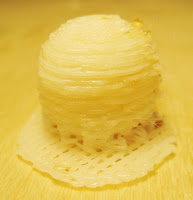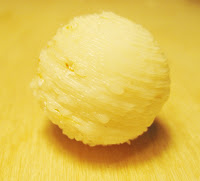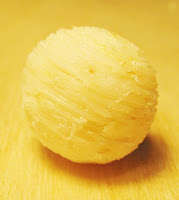Sunday, November 30, 2008
Sphere



I tried an experiment in support material. The idea was to use the same extruder for both support and build. The host software allows you to do this but it's a relatively recent change. It's not available in any of the official releases (I think, correct me if I'm wrong on that) but, if you build from the SourceForge source, you can do this.
The first thing I did was create a second extruder in the host settings. I copied all the Extruder0 settings and made them Extruder1, then set NumberOfExtruders=2. Extruder1's settings differ from Extruder0's like this:
ExtrusionInfillWidth(mm)=2.4 (instead of 0.8)
NumberOfShells(0..N)=0 (instead of 1)
ExtrusionSpeed(0..255)=175 (instead of 215)
MaterialType(name)=support (instead of ABS)
The intent here was to make a sparse and loosely-bonded mesh. The lower extrusion speed causes the ABS to be stretched into thin threads. The wider infill width creates an open weave pattern. The zero shells removes the outline around each layer. The end effect is a structure that looks a bit like a plastic pot scrubber.
To test, I used a 20mm sphere with a support object. I exported the two objects as sphere.stl and sphere-supt.stl. Now, to get the two objects to print together, you have to do this:
1. Load sphere.stl (when prompted, choose ABS)
2. Select the object (this will bond the object to the next one loaded)
3. Load sphere-supt.stl (when prompted, choose support)
4. Position and orient the (bonded) object in the build area
Note: The select-and-load thing to bond objects is a relatively new feature too.
The first image above shows the object as printed. The blobiness is mostly due to not having a proper nozzle cleaner yet. The second image shows the object after picking the support material off using my fingernail. The support material crumbled off fairly easily from the lower layers but was more difficult on the upper ones. The third shows the object after cleanup using a Dremel.
The upper layers of the support object are probably unnecessary and do more harm than good. The build can support itself once it's past a 45 degree overhang. I might try again with smaller support object.
Sure, it's a long way to go to make what's essentially a marble but it was an interesting experiment. I haven't tried anything with a purely-horizontal overhang yet. Not sure how that'll turn out.
Comments:
<< Home
Steve - that's really cool :-)
Since I upgraded the software to do that, I haven't had a chance to test it in a real machine. Amazingly, it works...
Since I upgraded the software to do that, I haven't had a chance to test it in a real machine. Amazingly, it works...
Yep. It works fairly well. I was a bit concerned that the heater/thermistor loop would get confused getting instructions from two different sources but it seemed to work just fine.
Of course, I didn't try anything crazy like setting two different temperatures or trying to run "both" extruder motors at the same time.
The extruder seemed to work just fine switching between fast and slow speed as it was drawing. I suppose the other way to stretch out the filament would be to keep the extrusion motor running steady and increase XYFeedrate for Extruder1 instead.
Post a Comment
Of course, I didn't try anything crazy like setting two different temperatures or trying to run "both" extruder motors at the same time.
The extruder seemed to work just fine switching between fast and slow speed as it was drawing. I suppose the other way to stretch out the filament would be to keep the extrusion motor running steady and increase XYFeedrate for Extruder1 instead.
<< Home
